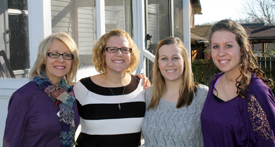
St. Louis Children’s Hospital is one of only two Level 1 Pediatric Trauma Centers in the region. While this distinction is impressive, it might not seem important—or relevant—to to you. But when it is your child who has suffered a traumatic injury—it does matter. And in many cases, a level 1 pediatric trauma center can mean the difference between life and death.
Richard and Rita Teague had never given trauma credentials much thought until the night their sixteen-year-old daughter, Anna, was airlifted to St. Louis Children’s from the site of a devastating motor vehicle accident.
“Anna was going to drive over to her sister’s house,” says her mother, Rita Teague. “It was only about a fifteen minute trip and she was supposed to call us when she got there. When we still hadn’t heard from her after a half an hour or so, we grew concerned. My husband decided to go look for her and he came up on the scene of an accident.”
Richard Teague walked a nightmare. Anna’s car had gone off the road and flipped several times. Washington Area Ambulance District was intubating her at the crash scene and a helicopter was on the way to “Air Evac” her to St. Louis Children’s Hospital. "My first thought," says Rita, when told how severe the accident appeared to be, “was to get my daughter on every church prayer list out there and to get as many people praying for her as possible."
“Every minute counts in a situation like this, says Diana Kraus, St. Louis Children’s Hospital Trauma Program Director. That’s why the state of Missouri has enacted laws to create the “Time Critical Diagnosis System.” The goal is to improve patient outcomes through a triage and transport protocol that ensures that the right patient is transported to the right facility, at the right time.”
According to Kraus, a Pediatric Trauma Center is distinguished from other facilities in that it guarantees the immediate availability of board certified pediatric specialists in surgery, neurosurgery, emergency medicine, anesthesia, critical care, neuro-rehabilitation and all the facilities to support the care of patients 24 hours a day. Nurses and other health care professionals are also required to have trauma training. In this way, it guarantees that all of the care team are speaking a common language and are available to patients when they are needed. It also guarantees that these services will be available around the clock, seven days a week. In Anna’s case, she was fortunate that the EMS providers made the call on the ground to send her to St. Louis Children’s Hospital.
When we arrived at Children’s Hospital, there were probably 15 people working on her,” says Rita. “The doctors were very direct with us and said suffered multiple skull and facial fractures, a subarachnoid hemorrhage, bilateral internal carotid artery dissections, two collapsed lungs, and a spinal injury. They were very clear about how seriously she was injured and that it did not look good for her in the long term.”
After a week and a half in the ICU, Anna remained in a coma. “There were other complications including significant blood clots in her carotid arteries. It was unclear whether she would ever again regain consciousness. At one point we decided we were not going to ask any questions because we couldn’t take any more bad news. We decided the best thing we could do was beg God to heal Anna. We asked for Him to guide the doctor's and nurse's hands and to give wisdom to all the rehabilitation team who were working so hard for her recovery.”
“For a patient with traumatic injuries like Anna’s, the best case scenario is to be taken to a facility that provides the highest level of trauma care,” says Kraus. “The EMS providers on the ground in Washington Missouri made the right call by sending her to St. Louis Children’s Hospital.”
The Teague family agrees. “St. Louis Children’s Hospital had everything Anna needed,” says Rita.” I didn’t realize until later that Anna had a nurse watching over her literally 24/7 while she was in the ICU. The doctors, the nurses, the therapists and staff took great care of her. While we didn’t always want to hear the bad news they needed to tell us, we knew they cared about her, our family, and her future.”
Slowly but surely, Anna regained consciousness. Her first word was “mom.” “I don’t know how Toni Goeltz, Anna’s physical therapist could make a child work so hard while managing to keep it fun. Anna also loved working with Casey Stallings, her speech therapist—she did so much for her. And Anna still laughs about lip-synching along with one of her favorite singers with Christy Merrell, the music therapist. All of the therapists would practically jump up and down with excitement or even shed a few tears as she achieved new milestones.”
Three months after the accident, Anna went home. Now, almost a year later, Anna has defied all of the odds and is back in school four days a week. Plans for college are around the corner.
“We are grateful to everyone from the person who heard the crash and called 911, to the EMS providers who took care of her at the scene, to her team at St. Louis Children’s Hospital. If not for them, the power of prayer, and Anna’s determination, we know this story would have had a very different ending.










